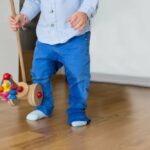Being a parent can be tough and most babies do not sleep well at least in the first few months. So I know as a parent of five children that those little bundles of joy more often than not love to fall asleep on our chests but this may not be the safest option for them.
Exhausted parents just want their little ones to sleep so that they too can rest and even possibly get some sleep but is it safe for your baby to sleep on your chest or stomach?
Let’s take a look at the reasons for and against as well as some alternatives that are a safer option but still allow parents to get some much-needed rest.
Should You Allow Your Baby To Sleep On Your Chest?
The quick answer is no you should not allow your newborn to sleep on your chest or stomach. This is because these are classed as unsafe sleeping positions and can increase the risk of sudden infant death syndrome (SIDS) as well as increasing the risk of accidental suffocation.
I know how hard it can be to try to establish a sleep routine, especially when you are exhausted from lack of sleep, having a newborn, remembering to eat and even shower.
But let me give you one little piece of advice as a mom of 5 children, establish that sleep routine right from the start – it will save you from exhaustion as well as saving your sanity I swear.
Don’t get me wrong there is nothing wrong with wanting to have that special one-on-one time with your little one or letting them occasionally fall asleep on you while you are wide awake.
It will not be the end of the world and it will not undo all your hard work of establishing a good sleep routine.
Risks For Baby If Sleeping On Your Chest
Having that skin-to-skin time with your baby is an extremely powerful and rewarding bonding experience. It is also recommended by the American Academy of Pediatrics (AAP).
But the one huge difference with regard to safety is that you must ensure that you are awake while you have this skin-to-skin time with your little one. The AAP does warn that falling asleep while your baby is sleeping on you, increases the risk of SIDS.
Where Should A Newborn Sleep?
Newborns should sleep in their own space whether this is a crib, bassinet, or play yard. It is recommended by the AAP that they should be placed on a firm surface and always be placed on their backs – this is to reduce the risk of SIDS.
It is also advised that there are no other sob objects such as bedding, bumpers, toys, or blankets in their sleeping area.
View in gallery
What If Your Baby Will Only Sleep On Your Chest?
If you are finding that your little one will only sleep on your chest then you may want to try some safer alternatives such as those listed below.
Swaddling
Swaddling your baby may provide them with the feeling of safety and security that they get from sleeping on your chest. If you haven’t already tried swaddling then it is definitely something that you should do.
Wrapping your baby or swaddling them as it is known will help to replicate the feeling of being snug and cozy in the womb and should help them to sleep better.
There is a huge range of different swaddling products available check out our reviews of the Woombie swaddle and the Love to dream swaddle for an idea of what is available.
Dock-A-Tot
To a tiny baby that has been all squished up in your womb for the past 9 months, suddenly finding themselves in a vast crib alone can be a scary experience and so they can not sleep properly.
This could be another reason why your infant is sleeping better on a parent’s chest. Many parents consider co-sleeping as a solution to this problem. A product like Dock-A-Tot allows you to safely co-sleep with your little one.
Prices pulled from the Amazon Product Advertising API on:
Product prices and availability are accurate as of the date/time indicated and are subject to change. Any price and availability information displayed on [relevant Amazon Site(s), as applicable] at the time of purchase will apply to the purchase of this product.
Bedside Sleeper
This is another alternative to co-sleeping that offers the best of both worlds without any of the risks. A bedside sleeper is a crib that attaches to the parent’s bed allowing for safe co-sleeping for parent and baby.
The only problem with these is that they tend to be quite small and so your baby will grow out of them quite quickly.
But the Mika Micky is on the larger side and potentially offers the chance for your little one to be able to sleep in it for an extended period of time – check out our full review of the Mika Micky here.
Sleep Training
If your little one is older than four months you could try sleep training although this does have mixed reactions amongst parents. But you have to do what you are comfortable with and what works for your family.
Many babies and children alike need to be taught how to sleep independently.
White Noise
Your baby may be the happiest sleeping on your chest as the familiar sound of your heartbeat echos around them. You may be able to fool your baby by using a white noise machine that has the heartbeat sound.
It probably will not cure their sleeping problem straight away but it may help them to start to sleep independently.
How To Help Your Baby Sleep Safely
Babies need to learn how to sleep and you can help them to sleep safely and also reduce the risk of SIDS and other sleep-related infant deaths.
There are around 3,500 sleep-related deaths among US babies each year. But parents can help to create a safe area for their baby to sleep by taking just a few steps.
- Always place your baby on their back for naps and at night. Even if a baby spits up while they are on their back their anatomy and gag reflex will help to prevent them choking in their sleep. Those babies that sleep on their backs are far less likely to die from SIDS compared to babies who sleep on their sides or even their stomachs.
- Ensure that your baby is sleeping on a firm, flat surfaces, such as a safety-approved mattress and this should only be covered in a fitted sheet. Although a soft surface may appear to be more comfortable to parents it can also increase the risk of sleep-related death and sleeping on a firm surface reduces the risk of SIDS as well as suffocation.
- Your baby’s sleeping area should be in the same room as you sleep until they are at least 6 months old, ideally until they are one year old. This in itself may decrease the risk of SIDS by as much as 50%.
- There should be no blankets, pillows, bumpers, or soft toys in their sleep area. Your baby should not be covered with additional sheets or blankets as these can cause your baby to overheat and pose a suffocation risk. If you are concerned about your little one getting cold during the night then you could always opt for a baby sleeping bag or something similar.
Safety And Co-Sleeping
Co-sleeping is a common practice amongst parents and I for one am certainly guilty of it. But why do parents co-sleep but yet still worry about the risks that are associated with it?
Many parents continue to co-sleep in order to bond with their baby or to make nursing easier or simply because their baby won’t sleep anywhere else.
But bed-sharing does come with its own risks and studies have shown that around half of all suffocation deaths among infants happen in an adult bed.
But there are many dangers lurking in an adult bed for a tiny baby, from a soft mattress to large pillows, fluffy blankets, and comforters.
Another mistake that sadly many parents believe is that they are in fact light sleepers and would wake if they rolled over on their baby, but there are many tragic stories that prove otherwise.
If you do wish to co-sleep then the safest way to do this is either in a bedside crib or a product like Dock-A-Tot. Both these options allow you to keep your baby close while still keeping them separate and giving them their own space.
Sleeping on The Couch With Baby
This is the most dangerous place to fall asleep with your baby as couches are so soft and plush and it is super easy for mom or dad to roll over and suffocate baby or for baby to fall off the couch onto the floor.
But yet many parents still couch share with their infants and are often surprised that it is so risky.
If you love this time to bond with your baby which many parents do then a safer option is to do it before they go to bed and then pop them in their crib, bassinet, or bedside crib.
When you are exhausted which every parent is at some point try to avoid nursing or feeding your baby on the couch as you are far more likely to nod off once you get in a comfy spot.
View in gallery
Safe Sleep Rules For Naps Too!
Many parents follow the safe sleep rules for nighttime to the letter, never even thinking to deviate but yet when it comes to nap time those same rules are thrown out the window.
Often parents believe that they do not need to worry about SIDS or other safety issues during the day because they are up and about and watching their little one. But it takes just a momentary lapse in concentration for tragedy to strike.
Research has shown that those infants who normally sleep on their back but are occasionally placed on their belly for naps are 18 times more likely to die from SIDS.
The experts have absolutely no idea why this is the case but they do have one theory and that is that those babies who normally sleep on their backs develop their motor skills differently so when they are placed on their belly they can not lift their head as easily putting them at risk of suffocation.
Skin To Skin
As a parent, I completely understand that you want to keep your baby close and have that special skin-to-skin contact with them.
It has also been shown in studies that those babies that are placed skin-to-skin immediately after birth adjust to life outside the womb easier, stay warmer, cry less, and breastfeed sooner.
Both the AAP and Lamaze recommend at least an hour of skin-to-skin contact straight after birth or as soon as you are medically stable and awake.
FAQs
Is it bad to let baby sleep on you?
Allowing your newborn to sleep on you while you are awake is perfectly safe and in fact, can be one of the most precious moments in those early days.
But if there is the smallest possibility that you may nod off it is always best to put them in their crib to sleep on their back as per the recommended safe sleep guidelines.
Can I let my baby sleep on his stomach if I watch them?
Tummy time is definitely an important part of your baby’s development but this should only be done under supervision and while your baby is awake. Your baby should not be allowed to sleep on their stomach until they are at least 12 months old.
Can baby sleep on their stomach on you?
Sleeping on their stomach is classed as an unsafe sleeping position for babies as it can increase the risk of Sudden Infant Death Syndrome (SIDS).
The Final Thought
Ask any parent and they will happily tell you how much sleep you actually get after a baby is born and the answer will always be “very little”.
So it is completely understandable that parents will allow their little ones to sleep anywhere in order that they themselves can get some much-needed shut-eye.
However, they may not fully understand the potential danger that they are putting their little one in by not following the safe sleep guidelines.
Hopefully, we have shown you some great alternatives that allow you to still keep your baby close while also keeping them safe!









